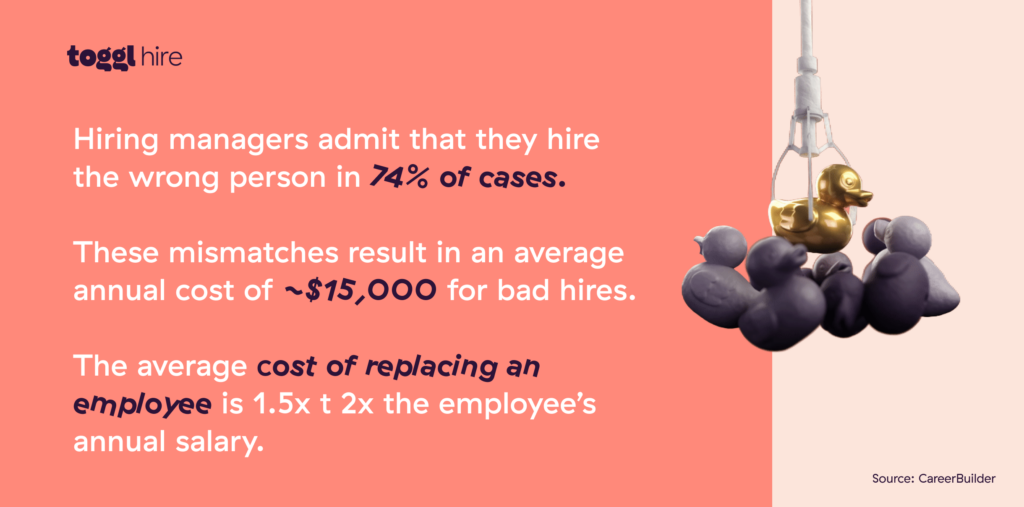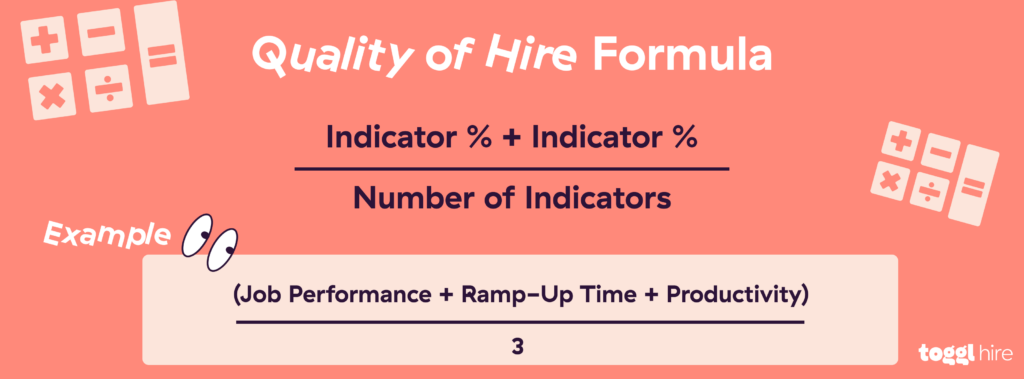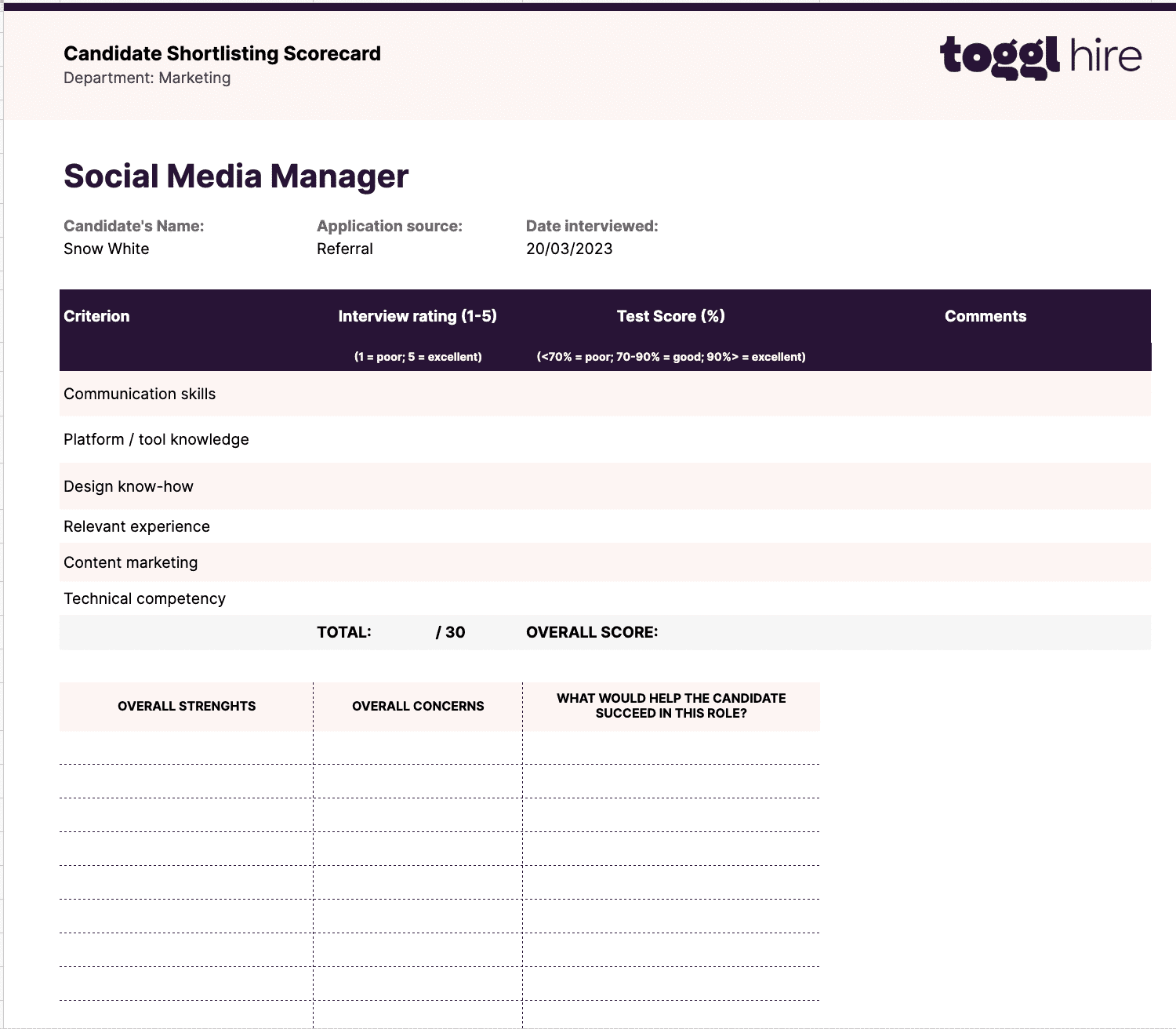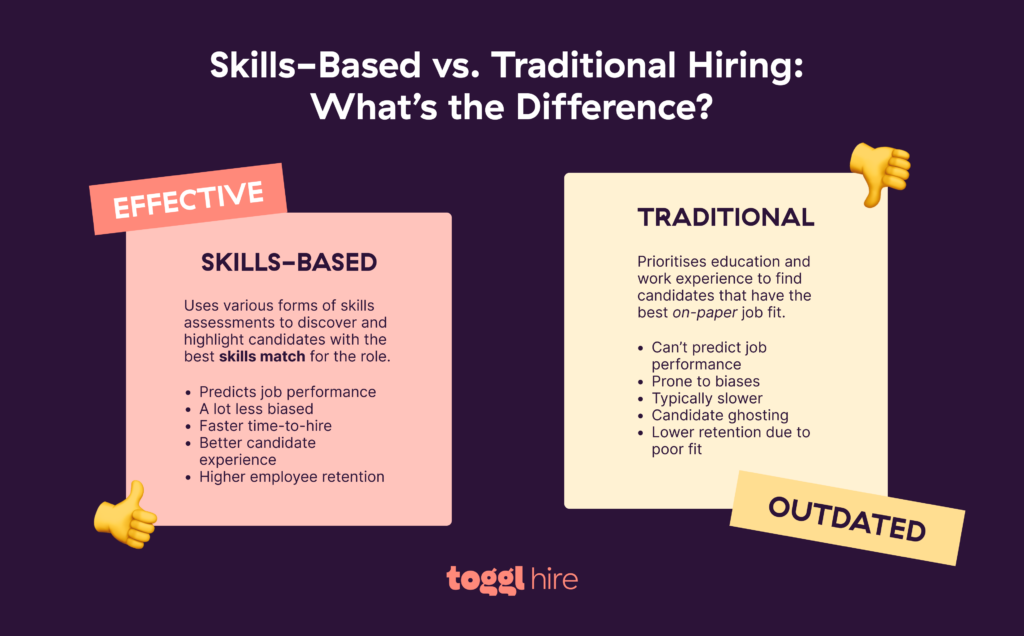If you’re an HR professional, you know all too well how painful it is to see a new hire fall flat or disappear faster than a slice of cake at an office birthday party.
If you’re tired of the endless cycle of hiring and firing, learning how to measure and improve your quality of hire could be the solution you’ve been searching for. Improving this important metric can help prevent costly hiring mistakes, boost productivity, and enhance employee morale.
In fact, when you learn how (and why) to dig deeper into your team’s quality of hire metrics, such as new hire attrition, employee engagement, hiring manager satisfaction, and feedback from new hires, finding the perfect candidate can be a cinch.
Hiring for quality is fundamentally different than just filling positions. To do it right, you have to track performance metrics like quality of hire and return on investment.
Lou Adler, CEO & Founder of The Adler Group
TL;DR — Key Takeaways
- Quality of hire is a vital hiring metric that reflects the value a new employee brings to an organization.
- Measuring and improving quality of hire can help hiring teams avoid the high costs of a bad hire, attract top talent in a competitive market, and help boost employee engagement and productivity.
- There’s no one-size-fits-all way to measure quality of hire. Instead, you’ll want to see which recruiting metrics are most important to your team or organization and learn to prioritize those as part of improving the quality of your hires.
- Relying on a data-driven hiring process, gathering candidate feedback, and implementing a skills-based hiring process are all simple ways to improve quality of hire.
What is quality of hire?
Quality of hire, otherwise known as QoH, is a hiring metric that reflects the value a new employee brings to an organization. It’s a comprehensive way to measure how successful a new hire will be in their role, and it encompasses both the pre-hire and post-hire experience.
💥 Pre-hire quality of hire measures can include assessment scores.
💥 Post-hire quality of hire measures can include things like time to proficiency or time to productivity.
By establishing a baseline for each of these metrics, you can begin to see which factors correlate with successful hires to predict quality and achieve hiring success.

Why is the quality of hire important?
Quality is better than quantity, especially in the hiring process. When hiring, identifying candidates with the right skill set, experience, and cultural fit is a must. But it’s not just about filling a position; it’s about finding a great addition to your team who will boost your bottom line and productivity.
Measuring quality of hire is key in achieving this, allowing you to assess how successful your hiring efforts have been and if they’ve contributed to the growth of your business. Here are a few reasons why.
Bad hires are expensive
For most companies, the cost of a bad hire is high — like really high.
- On average, it costs $4,425 to hire a new employee. If you make a bad hire and they leave soon after onboarding, that’s thousands of dollars down the drain!
- According to CareerBuilder, the cost of a bad hire is nearly 3x that — at a whopping cost of $17,000. Similar studies from Northwestern University estimate it’s about $15,000.
Additionally, the United States Department of Labor estimates a bad hire can cost you 30% of that person’s first-year salary, making it incredibly important to measure quality to ensure you’re hiring the right person for the job the first time around.
Top talent cares about quality
To attract and retain the best talent, you need to be able to show that you’re making quality hires. After all, the best candidates are highly skilled and ambitious, and working with a similar caliber of people is a compelling incentive to join a team. Ultimately, the quality of your hires will give you a leg up in the talent acquisition process.
Boost employee engagement
The quality of your team has a direct impact on your company’s bottom line. A new hire with poor performance can lead to a steep decline in employee engagement and other business metrics. Alternatively, quality hires bring fresh perspectives, new skills, and overall energy to your team, ultimately improving performance and workplace engagement.

8 ways to measure quality of hire
While quality of hire is a key recruiting metric, you measure it using other recruiting metrics or indicators, which is why it’s often so difficult for teams to track and improve.
Lars Schmidt, the founder of Amplify Talent, told SHRM, “In an ideal world, you’d have a connection and an understanding of hires and performance over time that could be segmented by recruiter, manager, and team to truly understand the impact those relationships are having on quality of hire.”
Other HR professionals have pointed out that the way you measure this metric will ultimately depend on your core priority — as in, what do you hope to improve about your hiring process by measuring quality of hire?
Generally, there is no one-size-fits-all metric for quality of hire because it depends on what your priority is. Common quality-of-hire metrics include turnover rates, job performance, employee engagement and cultural fit measured by 360 ratings.
Ji-A Min, Research Analyst at Ideal Candidate
As you can see, there are a few different ways to measure the quality of hire. Here are eight of the most common ways — all are great starting points from which to start measuring this metric, but you can adapt and customize the way you measure QoH depending on your organization’s needs.

1. End of probation period
Most new hires have a specific period within which to showcase their job performance. Typically, this period is three months (or 90 days), which is just long enough to evaluate the hire’s on-the-job performance. The countdown will begin from the day the new employee starts to exactly three months in the future.
This is the easiest of all the quality of hire metrics. For example, if you’re using Excel, use this formula:
=EDATE(Start_date,Months)
2. Ramp up time for new hires
This is the amount of time it takes for new hires to reach their full potential within the organization. Be aware that it will be different for each department — it can take up to 90 days for a new hire to reach full autonomy in some cases, or much shorter for entry-level roles.
Here are a few ways to measure it:
☝️ Observe and take notes during the first few weeks on the job. This is the most precise way to measure but also the most time-consuming.
✌️ Ask hiring managers how the new hire is doing after 30, 60, and 90 days. This is less precise but still provides valuable data for the process.
Time To Achieve (TTA) = “How long do you expect new hires to reach their potential”
Actual Time To Achieve (ATTA) = “How long it’s actually taken new hires to reach their potential”
If these numbers are equal, you’re on track. The same goes for TTA being higher than ATTA.
3. New hires reaching acceptable productivity
This is a variation of the ramp-up time metric. It’s the amount of time it takes until a new hire is productive enough to work on their own without assistance.
The main difference is that this metric looks at overall productivity, not just how fast someone reaches their full potential. To measure this hire score, you can use the same methods as you would for ramp-up time.
It is also worth putting milestones such as role-specific KPIs in place to measure job performance. If you’ve hired a Social Media Manager, for example, track how they’ve helped increase your brand’s followers, engagement, and other key metrics that can help indicate productivity and impact.
4. Hiring manager satisfaction rating
Hiring manager satisfaction is an important recruitment metric because it looks at how satisfied the hiring manager is with the company’s hiring process and new employees. Because they’re not a part of the HR department (in most cases), they can provide valuable insight into how effective the recruitment process is.
Taken a few months after the new hire starts, hiring manager satisfaction surveys can help to optimize the recruiting process and, therefore, help ensure a better quality of hire. This is different from candidate satisfaction, which looks at what they think of your company’s hiring experience.
5. Job performance reviews
Performance reviews are a more formal way of measuring quality of hire and understanding how well a new hire is doing. Usually, these reviews are performed by the hiring manager and include a score on a scale (1-5, for example) to assist in measuring quality.
On a scale on 1-5, with 5 being the lowest, how would you rate:
💭 Your knowledge in the role
💭 Your compatibility with other team members
💭 Your ability to complete your tasks in a timely manner
💭 Unique ideas you bring to the company
For a more accurate performance review, incorporate 360-degree feedback sessions. This allows employees to score themselves while also receiving feedback from managers and their peers.
6. Promotions
This is a lagging indicator, but it’s still a good way to measure the quality of hire. Promotion rate and promotion frequency are the common quality of hire metrics, measured by tracking how many new hires are promoted within their first year and how often they were promoted since joining the company.
7. Culture fit
This is harder to measure as it is qualitative, but important nonetheless, as a bad culture fit can be just as costly as a bad hire. To measure culture fit, ask yourself:
- Does the hire uphold and adhere to the company values?
- Are they a good representation of the organization?
Send out a survey to the team a few months after the new hire starts. This will give you a sense of how well the new hire is integrating into the team.
8. Employee turnover and retention rate
This is another lagging indicator, but it’s still a good way to measure the quality of hire. Track how many new hires leave within their first year and use that as a metric. You can also track retention rates — the percentage of new hires who stay with the company after their first year. This will give you a more complete picture of the quality of hire.
6 steps to improve the quality of hire
Now that you know what quality of hire is and why it’s so important, let’s take a look at how you can improve it.
1. Define what quality of hire means for your company’s long-term success
The first step in improving the quality of hire is to sit down with your team and define what a successful hire looks like.
- What skills and experience are required?
- What are the key indicators of success?
Only once you have a clear definition can you start measuring quality and working on improving the quality of hire.
Invest in a good applicant tracking system (ATS), like Toggl Hire, to help you track and manage candidates throughout the hiring process. While having a great ATS helps manage the hiring process, it’s also crucial when working to keep track of the quality of hire metrics.
2. Relying on a data-driven hiring process
Data, data, data — never forget the importance of relying on data! Look at real numbers, feedback, and other metrics to make better hiring decisions and effectively measure quality of hire.
Perhaps the most effective way to do this is to use quality of hire data to inform your hiring process. This data can help you tweak your process and make it more effective.
3. Align the hiring team with the right requirements
Are your hiring managers aligned with the requirements of the role? If not, you run the risk of hiring someone who’s not a good fit for the team. This can lead to a high turnover rate and a drop in productivity.
To avoid this kind of miscommunication or misalignment, create a candidate scorecard that includes factors such as:
- Hard and soft skills
- The level of knowledge the candidate needs
- How long they’ve worked in specific or adjacent roles
This kind of scorecard provides an objective way to measure the quality of candidates during the interview process and prevents the hiring team from acting on an impulse or accidentally introducing unconscious bias. If you’re focusing on the diversity of new hires as one of the key recruiting metrics, then instilling a structured hiring process is even more important.
🔥 Don’t want to build your candidate scorecard from scratch? Download our free scorecard template for interviews.

4. Use skills assessments to increase recruiter productivity
Your recruiting process needs to be efficient and effective to maximize recruiter productivity. Otherwise, your hiring managers will struggle to filter out low-quality candidates and identify potentially great hires.
For example, utilizing pre-built skills assessments is a painless method of having multiple candidates complete standard and knowledge-testing tests — without spending much time on coming up with good questions and managing the whole process.
Don’t think this is that important? CareerBuilder found nearly 60% of bad hires occurred because they couldn’t produce the level of work required to succeed in the role, highlighting the need for recruiters and hiring managers to assess candidates for the right skills.
By incorporating competency skills assessments into your hiring process, you can free up time for recruiters to focus on finding the best candidates. They help recruiting teams improve the quality of hire by ensuring shortlisted candidates have the right skills for the job.
Here’s what that looks like in practice. 👇
5. Improve the onboarding experience for new hires
Let’s be honest: candidates talk to each other, and a sloppy onboarding process can have a major impact on your employer brand and other key metrics like employee retention and attrition.
To improve your onboarding experience, assess whether candidates:
- Understand your organization’s core goals and missions
- Understand the principles of how the organization works
- Receive hardware and system access in a timely manner
- Feel welcomed by the team and their manager
Regardless of what your current process looks like or how you improve it, the goal is to help new hires adjust to their new environment and get up to speed quickly.
6. Keep track of former employees and use their feedback to improve your process
Always keep track of former employees and candidates and use their feedback to improve your hiring process. Doing so allows you to learn from your mistakes and ensure you don’t repeat them in your future recruiting process.
In fact, when tracking feedback from former employees, an exit interview is a must for the human resource management department in almost any growing organization. Conduct thorough interviews with questions focused on how you can retain future quality employees.
Final thoughts on improving the quality of hire
Measuring quality of hire with the right hiring metrics is a top priority for any hiring manager. By taking the time to invest in a good process, you can improve the quality of your team and lower your turnover rate.
Follow the steps and tips above to create a process that works for your business and helps you source and retain only the best candidates. If you lack the tools necessary to create better job descriptions, hire for the right skills, and ultimately attract better candidates, try a skills-based hiring tool like Toggl Hire.

See how other companies have used skills assessment tests and other Toggl Hire features to improve their quality of hire and other recruitment metrics here.
Juste loves investigating through writing. A copywriter by trade, she spent the last ten years in startups, telling stories and building marketing teams. She works at Toggl Hire and writes about how businesses can recruit really great people.










